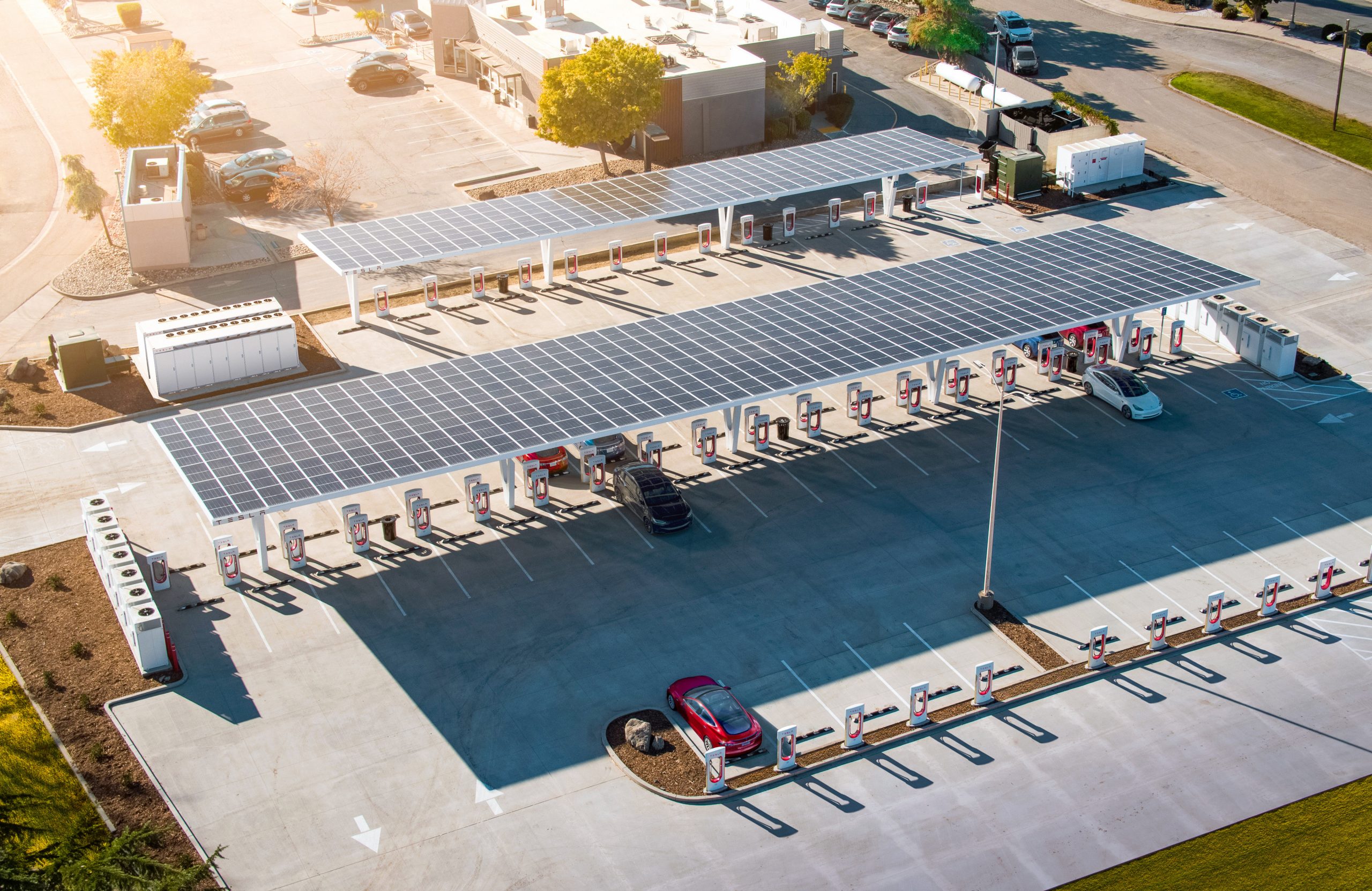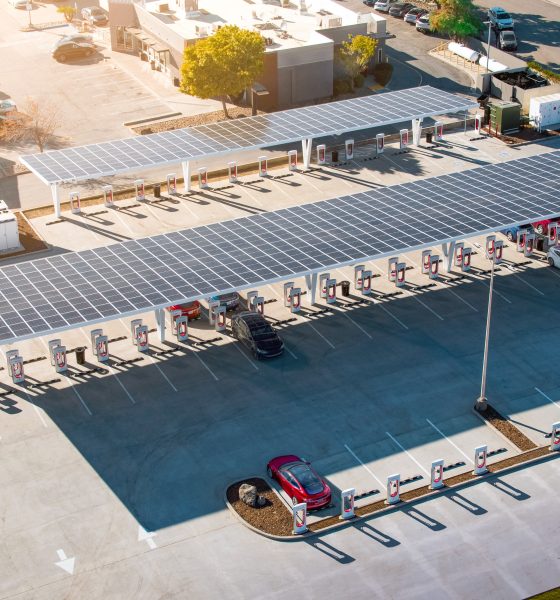

News
US official takes zero-Tesla road trip to promote EVs–things get so tricky they ended up ICE-ing a charger
United States Secretary of Energy Jennifer Granholm went on a four-day, 600+ mile journey from Charlotte, North Carolina, to Memphis, Tennessee, with a fleet of all-electric vehicles. The official’s entourage was impressive, as it included EVs like the Cadillac Lyriq, the Ford F-150 Lightning, and the Chevy Bolt. There were some combustion-powered cars in the entourage as well, but zero Teslas.
Over the US official’s journey, things would get so challenging that members of Granholm’s advance team resorted to eyebrow-raising tactics to secure fast chargers for the official. At one point, an ICE-ing incident happened, and police got involved. Needless to say, the Secretary of Energy’s EV road trip became a story worth telling — for better or for worse.
The distance itself between Charlotte and Memphis is not that far. At over 600 miles, the distance would likely require a Tesla just one or two stops at a Supercharger station. Granholm is knowledgeable about electric cars too, being one of EVs’ biggest advocates in the government. She also previously owned a Chevy Bolt and now drives a Ford Mustang Mach-E.
As noted by NPR reporter Camila Domonoske, who drives a Chevy Bolt herself, the US Secretary of Energy’s EV road trip was painstakingly mapped out ahead of time to allow for charging. The entourage stopped at hotels with Level 2 chargers and stopped at rapid chargers between cities. Advance teams would even head to fast chargers to make sure that the official and her team of EVs can recharge their batteries quickly.
Now, such a plan would probably be sufficient if the United States is known for having an expansive and reliable fast-charging network. But it’s not. Outside the Supercharger Network, which is privately operated by Tesla, the US’ rapid charging infrastructure leaves much to be desired.
This became evident when Granholm’s team was planning to fast charge at a station in Grovetown, a suburb of Augusta, Georgia. Upon arriving at the site, the official’s advance party realized that one of the station’s four chargers was broken and two were already occupied. With only one rapid charging stall open, an Energy Department staffer tried to ICE the stall to reserve it for the Secretary of Energy, who was on her way to the charging station.
ICE-ing, or the act of blocking an EV charging stall with a combustion-powered car, has been a headache for electric car owners for years. It was then no surprise that when the Energy Department staffer blocked the only free rapid charging spot in the site, EV owners were not pleased. A family that was boxed out of the charging stall was so upset that they called the police — and for good reason too. The day was extremely hot, and they had a baby in the car.
NPR’s Domonoske described the aftermath of the ICE-ing incident. “The sheriff’s office couldn’t do anything. It’s not illegal for a non-EV to claim a charging spot in Georgia. Energy Department staff scrambled to smooth over the situation, including sending other vehicles to slower chargers, until both the frustrated family and the secretary had room to charge,” she wrote.
As noted by Domonoske, outside of Tesla’s Supercharger Network, long road trips in the United States are still an issue. Fortunately, Tesla’s North American Charging Standard (NACS) is being adopted by an increasing number of automakers and charging companies, so it won’t be long before other electric cars can take advantage of a benefit that’s long been available to Tesla owners.
Don’t hesitate to contact us with news tips. Just send a message to simon@teslarati.com to give us a heads-up.

Elon Musk
Elon Musk’s X will start using a Tesla-like software update strategy
The initiative seems designed to accelerate updates to the social media platform, while maintaining maximum transparency.

Elon Musk’s social media platform X will adopt a Tesla-esque approach to software updates for its algorithm.
The initiative seems designed to accelerate updates to the social media platform, while maintaining maximum transparency.
X’s updates to its updates
As per Musk in a post on X, the social media company will be making a new algorithm to determine what organic and advertising posts are recommended to users. These updates would then be repeated every four weeks.
“We will make the new 𝕏 algorithm, including all code used to determine what organic and advertising posts are recommended to users, open source in 7 days. This will be repeated every 4 weeks, with comprehensive developer notes, to help you understand what changed,” Musk wrote in his post.
The initiative somewhat mirrors Tesla’s over-the-air update model, where vehicle software is regularly refined and pushed to users with detailed release notes. This should allow users to better understand the details of X’s every update and foster a healthy feedback loop for the social media platform.
xAI and X
X, formerly Twitter, has been acquired by Elon Musk’s artificial intelligence startup, xAI last year. Since then, xAI has seen a rapid rise in valuation. Following the company’s the company’s upsized $20 billion Series E funding round, estimates now suggest that xAI is worth tens about $230 to $235 billion. That’s several times larger than Tesla when Elon Musk received his controversial 2018 CEO Performance Award.
As per xAI, the Series E funding round attracted a diverse group of investors, including Valor Equity Partners, Stepstone Group, Fidelity Management & Research Company, Qatar Investment Authority, MGX, and Baron Capital Group, among others. Strategic partners NVIDIA and Cisco Investments also continued support for building the world’s largest GPU clusters.
News
Tesla FSD Supervised wins MotorTrend’s Best Driver Assistance Award
The decision marks a notable reversal for the publication from prior years, with judges citing major real-world improvements that pushed Tesla’s latest FSD software ahead of every competing ADAS system.

Tesla’s Full Self-Driving (Supervised) system has been named the best driver-assistance technology on the market, earning top honors at the 2026 MotorTrend Best Tech Awards.
The decision marks a notable reversal for the publication from prior years, with judges citing major real-world improvements that pushed Tesla’s latest FSD software ahead of every competing ADAS system. And it wasn’t even close.
MotorTrend reverses course
MotorTrend awarded Tesla FSD (Supervised) its 2026 Best Tech Driver Assistance title after extensive testing of the latest v14 software. The publication acknowledged that it had previously criticized earlier versions of FSD for erratic behavior and near-miss incidents, ultimately favoring rivals such as GM’s Super Cruise in earlier evaluations.
According to MotorTrend, the newest iteration of FSD resolved many of those shortcomings. Testers said v14 showed far smoother behavior in complex urban scenarios, including unprotected left turns, traffic circles, emergency vehicles, and dense city streets. While the system still requires constant driver supervision, judges concluded that no other advanced driver-assistance system currently matches its breadth of capability.
Unlike rival systems that rely on combinations of cameras, radar, lidar, and mapped highways, Tesla’s FSD operates using a camera-only approach and is capable of driving on city streets, rural roads, and freeways. MotorTrend stated that pure utility, the ability to handle nearly all road types, ultimately separated FSD from competitors like Ford BlueCruise, GM Super Cruise, and BMW’s Highway Assistant.
High cost and high capability
MotorTrend also addressed FSD’s pricing, which remains significantly higher than rival systems. Tesla currently charges $8,000 for a one-time purchase or $99 per month for a subscription, compared with far lower upfront and subscription costs from other automakers. The publication noted that the premium is justified given FSD’s unmatched scope and continuous software evolution.
Safety remained a central focus of the evaluation. While testers reported collision-free operation over thousands of miles, they noted ongoing concerns around FSD’s configurable driving modes, including options that allow aggressive driving and speeds beyond posted limits. MotorTrend emphasized that, like all Level 2 systems, FSD still depends on a fully attentive human driver at all times.
Despite those caveats, the publication concluded that Tesla’s rapid software progress fundamentally reshaped the competitive landscape. For drivers seeking the most capable hands-on driver-assistance system available today, MotorTrend concluded Tesla FSD (Supervised) now stands alone at the top.
News
Elon Musk’s Grokipedia surges to 5.6M articles, almost 79% of English Wikipedia
The explosive growth marks a major milestone for the AI-powered online encyclopedia, which was launched by Elon Musk’s xAI just months ago.

Elon Musk’s Grokipedia has grown to an impressive 5,615,201 articles as of today, closing in on 79% of the English Wikipedia’s current total of 7,119,376 articles.
The explosive growth marks a major milestone for the AI-powered online encyclopedia, which was launched by Elon Musk’s xAI just months ago. Needless to say, it would only be a matter of time before Grokipedia exceeds English Wikipedia in sheer volume.
Grokipedia’s rapid growth
xAI’s vision for Grokipedia emphasizes neutrality, while Grok’s reasoning capabilities allow for fast drafting and fact-checking. When Elon Musk announced the initiative in late September 2025, he noted that Grokipedia would be an improvement to Wikipedia because it would be designed to avoid bias.
At the time, Musk noted that Grokipedia “is a necessary step towards the xAI goal of understanding the Universe.”
Grokipedia was launched in late October, and while xAI was careful to list it only as Version 0.1 at the time, the online encyclopedia immediately earned praise. Wikipedia co-founder Larry Sanger highlighted the project’s innovative approach, noting how it leverages AI to fill knowledge gaps and enable rapid updates. Netizens also observed how Grokipedia tends to present articles in a more objective manner compared to Wikipedia, which is edited by humans.
Elon Musk’s ambitious plans
With 5,615,201 total articles, Grokipedia has now grown to almost 79% of English Wikipedia’s article base. This is incredibly quick, though Grokipedia remains text-only for now. xAI, for its part, has now updated the online encyclopedia’s iteration to v0.2.
Elon Musk has shared bold ideas for Grokipedia, including sending a record of the entire knowledge base to space as part of xAI’s mission to preserve and expand human understanding. At some point, Musk stated that Grokipedia will be renamed to Encyclopedia Galactica, and it will be sent to the cosmos.
“When Grokipedia is good enough (long way to go), we will change the name to Encyclopedia Galactica. It will be an open source distillation of all knowledge, including audio, images and video. Join xAI to help build the sci-fi version of the Library of Alexandria!” Musk wrote, adding in a later post that “Copies will be etched in stone and sent to the Moon, Mars and beyond. This time, it will not be lost.”








